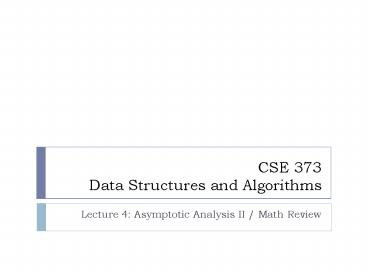CSE 373 Data Structures and Algorithms PowerPoint PPT Presentation
Title: CSE 373 Data Structures and Algorithms
1
CSE 373Data Structures and Algorithms
- Lecture 4 Asymptotic Analysis II / Math Review
2
Big-Oh notation
- Defn f(n) O(g(n)), if there exists positive
constants c and n0 such that f(n) ? c g(n)
for all n ? n0 - Asymptotic upper bound
- Idea We are concerned with how the function
grows when N is large. - We are not concerned with constant factors
- Lingo "f(n) grows no faster than g(n)."
3
Functions in Algorithm Analysis
- f(n) 0, 1, ? ? ?
- domain of f is the nonnegative integers (count of
data) - range of f is the nonnegative reals (time)
- We use many functions with other domains and
ranges. - Example f(n) 5 n log2 (n/3)
- Although the domain of f is nonnegative integers,
the domain of log2 is all positive reals.
4
Big-Oh example problems
- n O(2n) ?
- 2n O(n) ?
- n O(n2) ?
- n2 O(n) ?
- n O(1) ?
- 100 O(n) ?
- 214n 34 O(2n2 8n) ?
5
Preferred Big-Oh usage
- Pick tightest bound. If f(n) 5n, then
- f(n) O(n5)
- f(n) O(n3)
- f(n) O(n log n)
- f(n) O(n) ? preferred
- Ignore constant factors and low order terms
- f(n) O(n), not f(n) O(5n)
- f(n) O(n3), not f(n) O(n3 n2 n log
n) - Wrong f(n) ? O(g(n))
- Wrong f(n) ? O(g(n))
6
Show f(n) O(n)
- Claim 2n 6 O(n)
- Proof Must find c, n0 such that for all n gt n0,
2n 6 lt c n
7
Big omega, theta
- big-Oh Defn f(n) O(g(n)) if there exist
positive constants c and n0 such that f(n) ? c
g(n) for all n ? n0 - big-Omega Defn f(n) ?(g(n)) if there exist
positive constants c and n0 such that f(n) ? c
g(n) for all n ? n0 - Lingo "f(n) grows no slower than g(n)."
- big-Theta Defn f(n) ?(g(n)) if and only if
f(n) O(g(n)) and f(n) ?(g(n)). - Big-Oh, Omega, and Theta establish a relative
ordering among all functions of n
8
Intuition about the notations
notation intuition
O (Big-Oh) f(n) ? g(n)
? (Big-Omega) f(n) ? g(n)
? (Theta) f(n) g(n)
9
Little Oh
- little-Oh Defn f(n) o(g(n)) if for all
positive constants c there exists an n0 such that
f(n) lt c g(n) for all n ? n0. In other words,
f(n) O(g(n)) and f(n) ? ?(g(n))
10
Efficiency examples 3
- sum 0
- for (int i 1 i lt N N i)
- for (int j 1 j lt N N N j)
- sum
- What is the Big-Oh?
11
Math background Exponents
- Exponents
- XY , or "X to the Yth power"X multiplied by
itself Y times - Some useful identities
- XA XB XAB
- XA / XB XA-B
- (XA)B XAB
- XNXN 2XN
- 2N2N 2N1
12
Efficiency examples 4
- sum 0
- for (int i 1 i lt N i c)
- sum
- What is the Big-Oh?
13
Efficiency examples 5
- sum 0
- for (int i 1 i lt N i c)
- sum
- What is the Big-Oh?
- Equivalently (running time-wise)
- i N
- while (i gt 1)
- i / c
14
Math background Logarithms
- Logarithms
- definition XA B if and only if logX B A
- intuition logX B means "the power X must be
raised to, to get B - In this course, a logarithm with no base implies
base 2.log B means log2 B - Examples
- log2 16 4 (because 24 16)
- log10 1000 3 (because 103 1000)
15
Logarithm identities
- Identities for logs
- log (AB) log A log B
- log (A/B) log A log B
- log (AB) B log A
- Identity for converting bases of a logarithm
- examplelog4 32 (log2 32) / (log2 4)
5 / 2
16
Techniques Logarithm problem solving
- When presented with an expression of the form
- logaX Y
- and trying to solve for X, raise both sides to
the a power. - X aY
- When presented with an expression of the form
- logaX logbY
- and trying to solve for X, find a common base
between the logarithms using the identity on the
last slide. - logaX logaY / logab
17
Prove identity for converting bases
- Prove logab logcb / logca.
18
A log is a log
- We will assume all logs are to base 2
- Fine for Big Oh analysis because the log to one
base is equivalent to the log of another base
within a constant factor - E.g., log10x is equivalent to log2x within what
constant factor?
19
Efficiency examples 6
- int sum 0
- for (int i 1 i lt n i)
- for (int j 1 j lt i / 2 j 2)
- sum
20
Math background Arithmetic series
- Series
- for some expression Expr (possibly containing i),
means the sum of all values of Expr with each
value of i between j and k inclusive - Example
- (2(0) 1) (2(1) 1) (2(2) 1) (2(3)
1) (2(4) 1) 1 3 5 7 9 25
21
Series Identities
- Sum from 1 through N inclusive
- Is there an intuition for this identity?
- Sum of all numbers from 1 to N1 2 3 ...
(N-2) (N-1) N - How many terms are in this sum? Can we rearrange
them?

